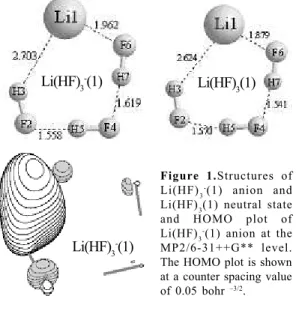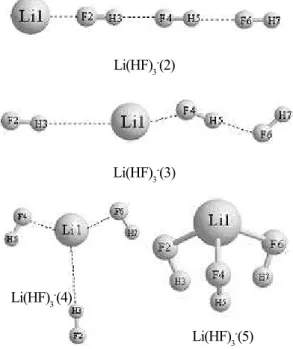www.scielo.br/eq
Covalent anion of Li(HF)
3-system. An ab initio study
J. Lu1, A. F. Jalbout 2,3*Z. Zhou1
1Department of Chemistry, Qufu Normal University, Shandong, Qufu 273165, People’s Republic of China and
State Key Laboratory of Crystal Materials, Shandong University, Shandong,Jinan 250100, People’s Republic of China.
2International Research Enterprises, 811 N Alvernon Rd., Tucson, Arizona 85711 USA 3Department of Chemistry, The University of Arizona, Tucson, Arizona, 85721, USA
*afjalbout@lycos.com
Abstract:In this paper, we report the stability of the Li(HF)3- molecular anion calculated at the MP2/6-31++G** and CCSD(T)/6-MP2/6-31++G** level of theory. Five possible conformers of Li(HF)3- molecular anions have been determined employing ab initio MP2 method with 6-31++G** basis set. The most stable conformer of five Li(HF)3- anions is in a cyclic ring structure Li(HF)
3
-(1). From our calculations we show that the molecule is stable towards electron attachment, with an electron adiabatic electron affinity (AEA) of 199.5 meV (233.1 meV with zero point energy correction) and 471.3 meV at the MP2 and CCSD(T) levels, respectively. In addition we present vertical detachment energies of 230.2 meV and 795.8 meV at the MP2, CCSD(T), respectively. The importance of the latter has to do with the ability of experimental detection of this value.
Keywords: Li systems; covalent anion; ab initio; electron affinity; vertical detachment energy.
Introduction
The study of HF clusters in theoretical chemistry has gone back via an extensive array of previous studies. It begins with the theoretical study of the dipole-bound states of these molecules [1]. In this study Adamowicz and co-workers explored the neutral structure and anions of (HF)3- as well as (HF)
4
-. They concluded that the most stable anion structures were in a cyclic ring structure. They also computed a vertical detachment energy (VDE) of 210 meV and an adiabatic electron affinity (AEA) of 44 meV, thus exemplifying some stability in relation to ionization. In subsequent studies a system of anions with suspended electrons (AISE) was investigated [2] for the (HF)3- system. In this study it was shown that the most stable arrangment of HF molecules was in a (HF)2···e···HF, where e is an excess electron. This type of system was predicted to result from electrostatic and dispersion interactions from the HF monomers, yielding an interatomically solvated electron. A VDE value of around 44 meV was obtained, which was an excellent agreement with the experimental data of 43 meV when CCSD(T)
calculations were carried out on MP2 geometries. It was concluded, that although these systems are higher in energy than typical dipole-bound or covalent anions, their stability in the gas phase is probably due to kinetic factors, and that they can form at elevated temperatures. After these calculations were performed, we later extended this work to show that the electrostatic field of a larger (FH)4·e·(HF)4 can also trap excess electrons in the same manner [3].
In this paper we propose the complexation of a Li atom with the (HF)3- system. We consider the most stable anion arrangments as considered by Adamowicz and co-workers, and extend it to our systems. Five conformers of Li(HF)3- anions have been found at the MP2/6-31++G** level. Our calculations suggest that the most stable structure is a cyclic-Li(HF)3- molecular framework. This can be seen from the energies in Table 1. We also present VDE values and IR frequencies which are useful in experimental verifications of electronic structure calculations [4] via Photoelectron Spectroscopy (PES) methods.
Ecl. Quím., São Paulo, 32(2): 55-59, 2007
Results and Discussion
The main question we are trying to answer here is if there is a stable complex that can form between the HF trimer anion system and Li, and if so to calculate a structure and a VDE value for it. To do this we have carried out calculations with the GAUSSIAN03 [5] software package. Five possible conformers of Li(HF)3/Li(HF)3- system have been found with the MP2/6-31++G** level. The adiabatic electron affinities (AEA) and the vertical electron detachment energies (VDE) of five Li(HF)3/Li(HF)3- system have been calculated employing ab initio Hartree-Fock, second-order Moller-Plesset perturbation theory (MP2) method and the coupled cluster CCSD and CCSD(T) methods with 6-31++G** basis set, respectively. The values calculated are displayed in Table 2. In addition 3D plot of the most stable anionic orbital was carried out with the MOLDEN package [6]. The results will be described below.
In Table 1 we present the total energies of the systems (in hartrees/particle) at MP2/6-31++G** level. From Table 1, we can see that the energy orders of five Li(HF)3- anionic states and five Li(HF)3 neutral states are both E(2)> E(3)> E(4)> E(5)> E(1). This indicates that the Li(HF)3(1) are the most stable conformers both in anionic and neutral states. However, the conformers of Li(HF)3(2) are not stable both in anionic and neutral states, which is different from the situation the most stable arrangment of HF molecules was in a (HF)2···e···HF in the (HF)3- system[2].
Li(HF)3-(1)
Li(HF)3(1)
Li(HF)3-(1)
Figure 1.Structures of Li(HF)3-(1) anion and Li(HF)3(1) neutral state and HOMO plot of Li(HF)3
-(1) anion at the MP2/6-31++G** level. The HOMO plot is shown at a counter spacing value of 0.05 bohr –3/2.
From Figure 1 we can see the most stable structure of the Li(HF)3- anion system. The structure of Li(HF)3(1) neutral state is also displayed in Figure 1 in order to compare to the structure of Li(HF)3-(1) anion. As we can see for the Li(HF)3-(1) anion the Li-F6 distance between Li and the first HF system is around 2.0 angstroms, which is slight longer than that in Li(HF)3(1) neutral state, and around 2.7 angstroms between Li and the second HF monomer, which is also slight longer than that in neutral state. The HF—HF interaction distances occur at a distance of around 1.6 angstroms, which is quite typical for this type of interaction. The figure also shows the (highest occupied molecular orbital) HOMO plot of the most stable anion. It is quite interesting to see that majority of the electron density lies between the Li-F at which the highest distance separates them. This can be explained by electrostatic and dispersion interactions. The net atomic charge of atoms Li and F6 in Li(HF)3(1) molecule are 0.077 and –0.873, respectively, therefore the electrostatic interaction is attractive with each other. However, the net atomic charge of atoms Li and F6 in Li(HF)3 -(1) anion are –0.873 and –0.388, respectively, therefore the electrostatic interaction becomes repulsive with each other owing to their like electric charges.
In Table 2 we present the vertical detachment energies (VDE) and the adiabatic electron affinities (AEA) of the system all in meV. As we can see from the Table 2, for the most stable Li(HF)3(1)/ Li(HF)3-(1) system, with a cyclic structure, the anion is stable when compared to the neutral structure, with an MP2/6-31++G** AEA value of around 199.5 meV (233.1 meV with zero point energy correction) and a CCSD(T)/6-31++G**// MP2/6-31++G** value of around 471.3 meV. While
MP2 is known to provide very accurate geometries, as well as zero-point energies (ZPE), the CCSD(T) approximation to the energy is more accurate. When we compared the MP2/6-31+G* geometries to those of the CCSD(T)/6-31+G* the differences were minimal and we expect the same trend with a larger basis set.
After optimization of the anion structure, we wanted to calculate the vertical detachment energy (VDE) of it. In this computation we took the MP2
geometry from the previous calculation, and calculated the MP2/6-31++G** energy of the neutral molecule at the anion geometry.For the VDE we obtain a value of 230.2 meV (MP2), and 795.8 meV(CCSD(T)//MP2), which also shows stability relative to electron detachment. Overall, the anion appears to solvate charge very well as is evident by the high VDE values. The VDE value is important since it is an experimentally observable physical value.
Li(HF)3-(2)
Li(HF)3-(3)
Li(HF)3-(4)
Li(HF)3-(5)
Figure 2: Four metastable conformers of Li(HF)3 - anion
at the MP2/6-31++G** level.
In Figure 2, other four metastable conformers of Li(HF)3- anion at the MP2/6-31++G** level are displayed. For the Li(HF)3(2)/Li(HF)3-(2) system, with “linear” shape, the anion is not stable when compared to the neutral structure, with an MP2/6-31++G** AEA value of around –204.1 meV (-175.7 meV with zero point energy correction) and VDE value of –202.2 meV.
For the Li(HF)3(3)/Li(HF)3-(3) system, with “zig-zag” shape, with an MP2/6-31++G** AEA value of around 142.9 meV and VDE value of 163.8 meV, and this indicates that the anionic state is stable with respect to electron detachment adiabatically.
For the Li(HF)3(4)/Li(HF)3-(4) system, with “T” shape, with an MP2/6-31++G** AEA value of around 365.4 meV and VDE value of 403.1 meV, and this indicates that the anionic state is stable with respect to electron detachment adiabatically.
For the Li(HF)3(5)/Li(HF)3-(5) system, with “three-legged” shape, with an MP2/6-31++G** AEA value of around 231.3 meV and VDE value of 215.8 meV, and this indicates that the anionic state is stable with respect to electron detachment adiabatically.
Conclusions
In this work we have presented the electronic structure and vibrational frequencies for the most stable Li(HF)3(1)/Li(HF)3-(1) system. We have seen that the molecular structure is in fact cyclic, with the Li penetrating a chain of HF. In addition, we have shown that the VDE value of 795.8 meV at the CCSD(T)/6-31++G**//MP2/6-31++G** level of theory which represents a very good estimate of it. Other four metastable conformers of Li(HF)3/ Li(HF)3- system have been displayed in Figure 2. The AEA and VEA of five Li(HF)3/Li(HF)3- system have been calculated employing HF, MP2, CCSD and CCSD(T) methods and are listed in Table 2.
While the covalent anion of this system appears to be stable, the dipole moment (2.268 D) of the neutral Li(HF)3(1) structure was too low to faciliate dipole-bound anion attachment. We did try calculation of a dipole-bound system, however, we did not observe any diffuse s character which is indicative of a dipole bound anion [8-12].
The present calculations pose a very interesting problem for experimental verification. The increased recent interest in HF solvated systems lead us to the analysis of this anion. Particulary, the possibility of interatomic electron stabilization is very interesting to our research. As we saw for the Li—(HF)3 anion the excess electron density did reside in-between the Li-F bond of one of the subunits. Our current paper, can be used to justify the results in an alternate form of bonding, in which a metal molecule can also stabilize charge in small diatomic molecular cluster anions, and can be verified by an advanced form of Photoelectron Spectroscopy (PES).
References
[1] R. Ramaekers, D. M. A. Smith, J. Smets, L. Adamowicz, J. Chem. Phys. 107 (1997) 9475. [2] M. Gutowski, C.S. Hall, L. Adamowicz, J. H. Hendricks, H.L. de Clercq, S.A. Lyapustina, J.M. Nilles, S.-J. Xu, K.H. Bowen, Jr., Phys. Rev. Letts. 88 (2002) 143001.
[3] A.F. Jalbout, C.A. Morgado, and L. Adamowicz, Chem. Phys. Lett. 383, 317 (2004). [4] C. Defrançois, H. Abdul-Carime, J.P.
Schermann, J. Chem. Phys. 104 (1996) 7792. [5] M.J. Frisch et. al., GAUSSIAN03, Revision B.05, Gaussian, Inc., Pittsburgh, PA, 2003. [6] G. Schaftenaar, J.H. Noordik, J. Comput.-Aided Mol. Des. 14 (2000) 123.
[7] C.S. Hall, L. Adamowicz, J. Phys. Chem. A. 106 (2002) 6099.
[8] A.F. Jalbout, L. Adamowicz (submitted) [9] A.F. Jalbout and L. Adamowicz, J. Mol. Struct., 93 (2002) 605; Jalbout, A.F. Jalbout and L. Adamowicz, J. Phys. Chem. A. 105 (6) (2001) 1071.; A.F. Jalbout and L. Adamowicz, J. Phys. Chem. A. 105 (6) (2001) 1033.
[10] A.F. Jalbout, J. Smets, and L. Adamowicz, Chem Phys., 51 (2001) 273.
[11] A.F. Jalbout and L. Adamowicz, J.Chem.Phys 9672 (2002) 9672.
[12] A.F. Jalbout, K.Y. Pichugin, and L.
Adamowicz, Theoretica Chimica Acta 111 (2004) 358
Received 05 April 2007 Accepted 02 June 2007

